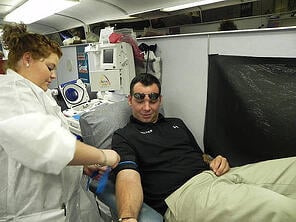 Every year in the United States more than 20 million units of red blood cells, platelets and plasma are transfused to treat conditions primarily in the area of: anemia, leukemia and sickle cell disease. Blood saves lives; it cannot be manufactured in a lab that’s why blood donors all over the world are given honorable mention.
Every year in the United States more than 20 million units of red blood cells, platelets and plasma are transfused to treat conditions primarily in the area of: anemia, leukemia and sickle cell disease. Blood saves lives; it cannot be manufactured in a lab that’s why blood donors all over the world are given honorable mention.
World Blood Donor Day: How Seniors View It
Since this year’s World Blood Donor Day—June 14 also marks a significant milestone for the organization—their 10th anniversary, we shall focus on what this day means for seniors. The “gift of life” from selfless volunteers has a special meaning for most of us, and for seniors who have seen the advent of blood transfusion transform from the early 19th century to what it is today, World Blood Donor Day holds even more significance. One of the common reasons for blood transfusion among ageing populations is anemia, a low blood count, which is temporarily disruptive in the young but life threatening in late adulthood.
Anemia in seniors often goes unnoticed, due to multiple health changes taking place during this stage of life. For caregivers and seniors who want to understand the condition a bit more, in addition to having the necessary assessment tools for appropriate care, discussed are: causes, signs and symptoms of anemia.
Causes, Signs and Symptoms of Anemia
Physicians don’t fully understand why anemia is a common and increasing problem for seniors 65 years and older. In many cases, geriatric anemia has no underlying causes, yet it is not a normal part of ageing. However, a few factors to watch out for are malnutrition or poor eating habits which lead to vitamin and iron deficiencies and chronic diseases (bone marrow problems, gastrointestinal conditions and chronic infections).
Signs and Symptoms of anemia include: a decrease in physical performance and strength as shown by poorer balance and hand grip strength, weakness, fatigue, pale skin, frequent headaches, dizziness, breathlessness, low body temperature and chest pain and cognitive impairment.
Symptoms are non-specific or resemble other medical conditions; also some doctors hold on to the old concept that anemia is part of aging; consequently, only when guided by YOU or caregivers will doctors’ test for anemia.
When Is It Necessary For Blood Transfusion?
Only when doctors recognize an immediate need to relieve anemic symptoms and support body tissues will blood transfusion be recommended; it’s not the preferred course of therapy; however, doctors opt to go this route, anyway. The first line of defense is usually to increase dietary nutritional value which includes iron therapy (folates, iron fortified cereals, iron supplements, etc.).
Left untreated, geriatric anemia results in a higher mortality rate and decreased bodily functions. Many can be easily controlled. Caregivers or seniors who recognize these symptoms can take action to improve overall management of their health.
Key Takeaways:
-
Blood saves lives; it cannot be manufactured in a lab, that’s why blood donors all over the world are honored.
-
One of the common reasons for blood transfusion among ageing populations is anemia.
-
Anemia in seniors often goes unnoticed, due to multiple health changes taking place during this stage of life.
-
Signs and symptoms of anemia include a decrease in physical performance and strength as shown by poorer balance and hand grip strength, weakness and mental impairment.
-
Blood transfusion is not the preferred course of action for the elderly; however, doctors opt to go this route, anyway.
-
Caregivers or seniors who recognize these symptoms can take action to improve overall management of their health.





 Every year in the United States more than 20 million units of red blood cells, platelets and plasma are transfused to treat conditions primarily in the area of: anemia, leukemia and sickle cell disease. Blood saves lives; it cannot be manufactured in a lab that’s why blood donors all over the world are given honorable mention.
Every year in the United States more than 20 million units of red blood cells, platelets and plasma are transfused to treat conditions primarily in the area of: anemia, leukemia and sickle cell disease. Blood saves lives; it cannot be manufactured in a lab that’s why blood donors all over the world are given honorable mention.